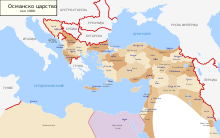

This is a bibliography of notable works about the Ottoman Empire.


This is a bibliography of notable works about the Ottoman Empire.

The Ottoman Empire, historically and colloquially known as the Turkish Empire, was an imperial realm that spanned much of Southeast Europe, West Asia, and North Africa from the 14th to early 20th centuries; it also controlled parts of southeastern Central Europe between the early 16th and early 18th centuries.

In Islam, the ulama, also spelled ulema, are scholars of Islamic doctrine and law. They are considered the guardians, transmitters, and interpreters of religious knowledge in Islam.

The historiography of the Ottoman Empire refers to the studies, sources, critical methods and interpretations used by scholars to develop a history of the Ottoman Dynasty's empire.

Timariot was the name given to a Sipahi cavalryman in the Ottoman army. In return for service, each timariot received a parcel of revenue called a timar, a fief, which were usually recently conquered plots of agricultural land in the countryside. Far less commonly, the sultan would grant a civil servant or member of the imperial family a timar. Also non-military timar holders were obliged to supply the imperial army with soldiers and provisions.

Köprülüzade Fazıl Ahmed Pasha was an Ottoman nobleman and statesman, who belonged to the renowned Köprülü family of Albanian origin, which produced six grand viziers of the Ottoman Empire.
In the Ottoman Empire, a millet was an independent court of law pertaining to "personal law" under which a confessional community was allowed to rule itself under its own laws.

The history of the Ottoman Empire in the 18th century has classically been described as one of stagnation and reform. In analogy with 18th-century France, it is also known as the Ancien Régime or Old Regime, contrasting with the "New Regime" of the Nizam-i Cedid and Tanzimat in the 19th century.
A kaza was an administrative division of the Ottoman Empire. It is also discussed in English under the names district, subdistrict, and juridical district. Kazas continued to be used by some of the empire's successor states. At present, they are used by Iraq, Lebanon, Jordan, and in Arabic discussion of Israel. In these contexts, they are also known by the Arabic name qada, qadā, or qadaa.

The Peace of Amasya was a treaty agreed to on May 29, 1555, between Shah Tahmasp of Safavid Iran and Sultan Suleiman the Magnificent of the Ottoman Empire at the city of Amasya, following the Ottoman–Safavid War of 1532–1555.
Esnaf is a Turkish word which means "corporation". During the Early Modern Period belonging to a guild gave people a voice and was an important part of one's identity. Handicraft producers were linked to one another by a range of social, political, and economic ties. Guilds varied among societies, social class, and genders. There were many misconceptions, differences, as well as similarities between Europe and the Ottoman Empire. There were hierarchies within guilds; sometimes they shared tools, worked together, or worked alone.

Idris Bitlisi, sometimes spelled Idris Bidlisi, Idris-i Bitlisi, or Idris-i Bidlisi, and fully Mevlana Hakimeddin İdris Mevlana Hüsameddin Ali-ül Bitlisi, was an Ottoman Kurdish religious scholar and administrator.
The Truce of Constantinople was signed on 22 July 1533 in Constantinople by the Ottoman Empire and the Archduchy of Austria.
Dina Rizk Khoury is a Lebanese-American historian, Guggenheim Fellow, Professor of History and International Affairs, at George Washington University and former President of the Middle East Studies Association of North America.
Haraç was a land tax levied on non-Muslim subjects in the Ottoman Empire.
Inspectorates-General or General Inspectorates was a regional governorship whose authorities prevailed over civilian, military and judicial institutions under their domain but had to comply with the orders of Turkish president Mustafa Kemal. Their aim was to establish an authoritarian rule and to consolidate the authority in the process of Turkification of religious and ethnic minorities.
Fitnat Hanım was the pen name of the Ottoman Turkish woman poet Zübeyde, "considered the most important woman poet of the Ottoman school".

The Ottoman decline thesis or Ottoman decline paradigm is an obsolete historical narrative which once played a dominant role in the study of the history of the Ottoman Empire. According to the decline thesis, following a golden age associated with the reign of Sultan Suleiman the Magnificent, the empire gradually entered into a period of all-encompassing stagnation and decline from which it was never able to recover, lasting until the dissolution of the Ottoman Empire in 1923. This thesis was used throughout most of the twentieth century as the basis of both Western and Republican Turkish understanding of Ottoman history. However, by 1978, historians had begun to reexamine the fundamental assumptions of the decline thesis.

The Transformation of the Ottoman Empire, also known as the Era of Transformation, constitutes a period in the history of the Ottoman Empire from c. 1550 to c. 1700, spanning roughly from the end of the reign of Suleiman the Magnificent to the Treaty of Karlowitz at the conclusion of the War of the Holy League. This period was characterized by numerous dramatic political, social, and economic changes, which resulted in the empire shifting from an expansionist, patrimonial state into a bureaucratic empire based on an ideology of upholding justice and acting as the protector of Sunni Islam. These changes were in large part prompted by a series of political and economic crises in the late 16th and early 17th centuries, resulting from inflation, warfare, and political factionalism. Yet despite these crises the empire remained strong both politically and economically, and continued to adapt to the challenges of a changing world. The 17th century was once characterized as a period of decline for the Ottomans, but since the 1980s historians of the Ottoman Empire have increasingly rejected that characterization, identifying it instead as a period of crisis, adaptation, and transformation.
The Second Inspectorate-General refers to a Turkish regional administrative subdivision comprising the provinces Edirne, Çanakkale, Kırklareli and Tekirdağ.